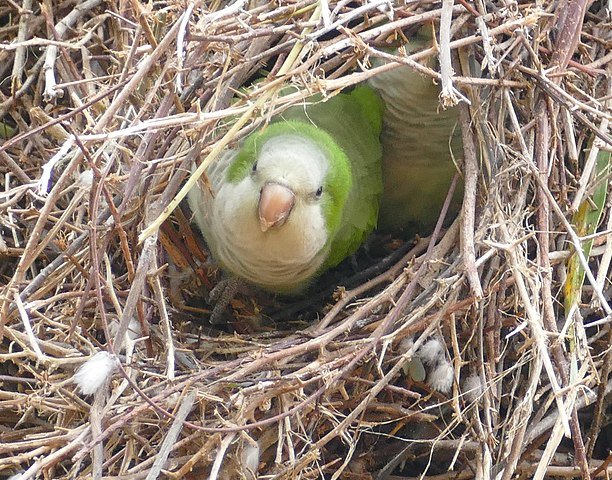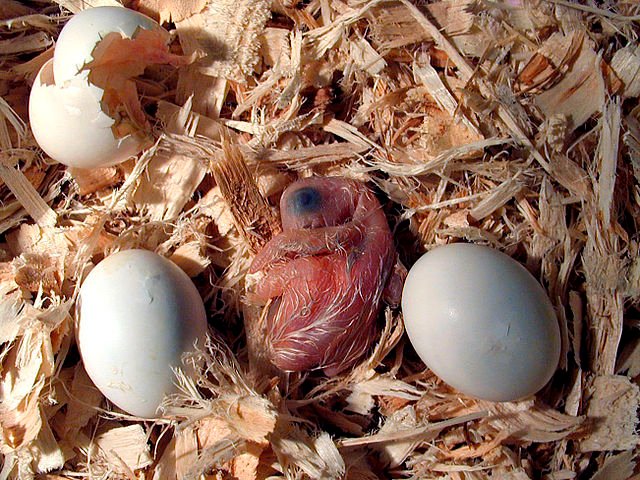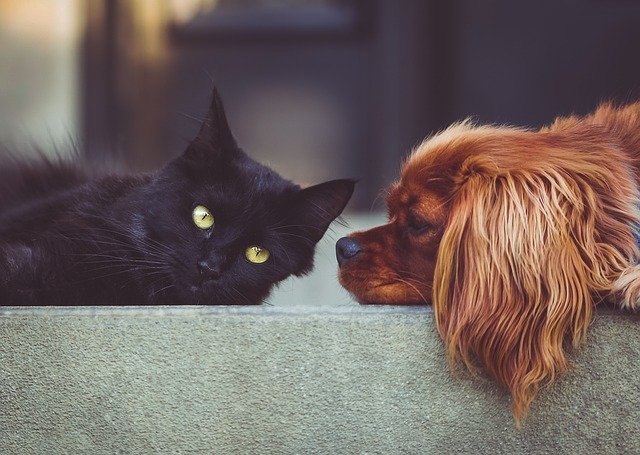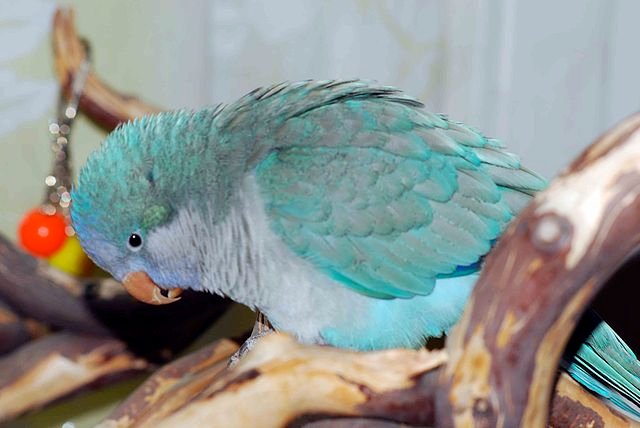Declared as crop pests in many states of The US, Quakers parrot’s feral population has increased in large numbers in recent years. And most of the credit goes to Quaker parrot egg-laying tendency. They attain sexual maturity early on which increases their number of mating seasons thereafter.
Unlike other famous parrot species, Quakers exhibit a unique behavior during breeding and egg-laying period. For them, it is more of an emotional act than a physical one and they work hard to infuse life to each egg the female Quaker lays.

With love and care, the offspring wins over all the hardships of infancy and is trained well by the male Quaker to live safely when he finally steps out of his apartment-like nest. Both male and female Quaker works as one family unit and divides all their duties and responsibilities pretty much like a new human to-be parents.
Quaker Parrot Egg Laying Behavior
With Quakers’ popularity on the rise as a bird pet, more and more people are interested in knowing even the minutest things related to these intelligent parrot species. From knowing their appropriate cage size to mastering the tricks to bond with them, the Quaker owners want to know it all. But it always works the best if we start things from the beginning and it all starts from ‘the egg’.

How to know when Quaker will lay eggs?
Just as sunrise is a follow-up to a night, egg-laying is a follow-up to the breeding of Quakers. Knowing their breeding time and the breeding signs thereof would help in understanding when the female might lay eggs. A female Quaker may lay eggs anytime after six months of age. She doesn’t necessarily need a mate to lay eggs. The hormonal changes or climatic conditions may force her to do so.
But one will know beforehand that she is wanting to lay eggs. She’ll show some behavioral changes like:
- She’ll start spending most of her time in a dark corner at the bottom of the cage instead of the perches.
- She’ll start tearing up papers and other such material to make a cage out of them.
- She’ll squat and start straining herself as if trying to lay an egg.
- She’ll suddenly start behaving in an extremely aggressive manner and will resort to biting the owner to take her frustration out.
- She’ll become extremely noisy with sudden bouts of screams now and then.
- She’ll start preening herself beyond the limit resulting in feather loss.
- She’ll become possessive of her cage and the belongings lying inside. An extreme condition of this would be her possessiveness for her human parent too.
- She might also try to woo the other cage mate or her owner, in the absence of any partner. Tail fanning, eye pinning, regurgitation, and wing flapping are few of the signs she might show before wanting to lay eggs.
Why is my Quaker parrot laying eggs?
The biggest myth many Quaker owners have that their bird cannot lay eggs alone. So, does female Quaker need a mate to lay eggs? The answer is a big NO. A female Quaker can certainly lay eggs both with or without a mate.
When a female Quaker lays eggs with the help of a mate, the eggs laid thereof are fertile ones. Upon hatching, the young ones will come out.
However, one might notice his female Quaker laying eggs even when she has never been introduced to any male partner. In such a scenario, she’ll still be able to lay eggs but those eggs will not hatch young ones as they were not fertilized by the male partner.
To discourage this, let her sit on those eggs to let her realize there is no point in laying eggs this way. This is important to protect the bird from multiple diseases she might develop by continuous egg-laying. And the major one among all is Egg Binding. The bird contracts it as she uses a lot of calcium from her body to make egg-shells. This could further cause her Osteoporosis.
How to stop my Quaker parrot from laying eggs?
The female Quaker lays eggs due to hormonal changes occurring during the usual breeding season of Quakers. She gets caught up with symptoms of breeding and starts laying eggs without any help from a mate.
To discourage her to do it in the first place and save the bird from getting deficient in calcium, few measures work like magic:
- Stop feeding them foods high in sugar content like fruits. This signals her brain to think about breeding. Switch fruits like bananas, apples, or grapes for a food high in fiber to discourage her for laying eggs.
- Change her routine by putting her to bed early. Making her days shorter would make her believe it’s still winter. Cover her cage to mimic darkness and let her sleep in silence.
- Do not let her create any dark nest-box like spaces inside her cage during the rainy season, i.e., starting from mid-fall to early spring.
Quaker parrot egg incubation
Incubation in Quaker parrots can happen via two methods, namely natural and artificial. Let us get into the details of these types for in-depth knowledge.
Natural Incubation
The Quaker parrot species lay eggs in around 24 hours after the fertilization of eggs. Most birds lay 4 to 8 eggs with a frequency of one egg each day. Quaker parrot egg hatching continues for about 19 to 21 days after the bird starts to sit on the eggs. Another clutch of Quaker parrot eggs follow in around 4 weeks.
During hatching, the baby Quaker draws egg sac into his abdomen as this sac supplies him food for the first few hours after hatching. It is, therefore, advised not to remove the shell of the baby Quaker in an attempt to help him come out as it will negatively impact his health.
Artificial Incubation
Artificial incubation becomes need of the hour where the Quaker pair is unable to incubate the egg successfully. And the reasons could be many: the bird injuring or killing the young ones while trying for incubation, she has frequently broken the egg with her beak in the past during the process, or lastly, she is habitual of abandoning her eggs by hiding it inside the nest or somewhere else.
Artificially incubating Quaker parrot eggs has shown a great success rate in such cases, if done properly. But it should be practiced only if one is sure that the breeding pair cannot incubate the eggs at all. Now, the question is how to incubate Quaker parrot eggs? Following the procedure step-by-step eliminates all the chances of failure:
- To artificially incubate the eggs, pull the eggs from the nest box very carefully. To protect the eggs from being destroyed by the bird pair, pull them as soon as Quaker parrot laid egg.
- Now, place all the eggs straightaway in the incubator. Keep the larger end of the incubator also known as air cell a little elevated. Maintain this elevation for a successful hatching procedure. One can keep a single gauze pad under the larger end to help it stay put. This would also keep the incubator from vibrating, thereby, causing probable damage to the eggs.
- For the maximum hatch rate, place smaller eggs at the incubator’s higher-end and the larger ones at the lower end of it. Now maintain a constant temperature of 99.3 degrees Fahrenheit and keep the humidity at 40 to 50 degrees.
- Set the incubator on automatic egg rotation every one to two hours. Also, make sure to manually rotate the eggs 180 degrees once a day as most of the incubators aren’t adept at proper full rotation.
- Candling eggs daily to look for abnormalities is a must for the highest success rate. Repair any cracked eggs and remove all the embryos that are dead-in-shell. Reposition the badly-positioned eggs as they might be causing trouble to the chicks in hatching
- When an egg is about to hatch, it is known as draw-down. To know which egg has entered the draw-down, notice all the eggs while candling. The eggs whose air-cell has become elliptical from the usual round shape and it is extending towards the side on the lower end, are the ones that qualify for draw-down. If you see the signs of draw-down in eggs, remove them and place them in a hatcher.
- Now let the eggs hatch properly in the hatcher. To maximize the chances, maintain a constant temperature of 99.3 degrees Fahrenheit and the humidity level at highest. Allow two to three days for the process to happen accurately.
Final Words
A Quaker parrot laying eggs that are fertile is completely normal and if the owner is ready to take the responsibility of the little young ones too, he can let her breed with her mate. But if even with a mate by her side, egg-laying is unwanted, one must start doing all the efforts to deter this behavior. Combine all the efforts even after she has started showing the breeding behavior and let the phase pass where she no longer feels the urge to extend her family.





